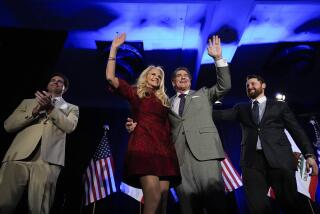Activists Vow to Restore Open Primary
- Share via
SACRAMENTO — What the U.S. Supreme Court took away on Monday, Californians will find a way to restore, vowed proponents of an open primary system that frees voters registered with the Democratic, Republican or any other party to pick candidates across party lines.
Californians established such a “blanket” primary in 1996 through a popular ballot measure. Just hours after the nation’s top court overturned that law Monday, its architects vowed to try again.
“We will raise what we need to raise and make it happen,” said Nick Tobey, a 29-year-old West Los Angeles art frame manufacturer who has been working since 1993 to give independent voters greater sway in elections.
As head of the group Californians to Protect the Open Primary, Tobey vowed to begin collecting the more than $1 million that he estimates it will take to gather enough signatures to put an open primary measure on the 2002 ballot. The March 1996 measure, Proposition 198, cost $995,000, he said, much of it donated by Silicon Valley entrepreneurs. Voters passed it, 59% to 41%.
While political party leaders loathe the blanket primary and filed the lawsuit that ultimately overturned it, polls show as many as 80% of the voters who used the system in June 1998 and March 2000 agreed that it made it easier for them to choose candidates more representative of their interests, according to the Secretary of State’s office.
On Monday, Democratic Gov. Gray Davis and Secretary of State Bill Jones, the state’s top-ranking Republican, both took a stance counter to their party leadership, promising to work toward reestablishing some form of an open primary. They praised it for drawing more voters to the polls and for giving a stake in elections to 2 million independents.
“As the first governor of California to be nominated in an open primary, I believe this process is good for voters and good for democracy,” Davis said in a written statement. He promised to “do everything within my power to find a constitutionally permissible way” to give California voters more choices.
Jones credited the blanket primary on March 7 with boosting voter turnout to its highest levels in 20 years for a presidential primary.
“This removes the power from us, the voters, and thwarts the will of all Californians,” Jones said of the court’s 7-2 decision.
The ruling should have no effect on the results of the last primary, Jones said. He promised to help craft a replacement for the “closed” primary to which the state will revert, at least until 2004--the soonest a new ballot measure could take effect if passed in 2002.
How a new ballot measure should be written in light of the U.S. Supreme Court decision isn’t clear, Tobey said. Various forms of open primaries are used by 20 states, and courts have endorsed some of them.
In Louisiana, for example, voters cast ballots across party lines, and the top two vote-getters face one another in the general election, even if both are from the same party. California might try such an approach, Tobey said, or consider allowing voters to change their party registration minutes before they enter a polling booth.
Jones argued at a news conference Monday that California’s blanket primary is scarcely different from open primaries that allow last-minute registration changes, a system that has not been struck down as unconstitutional. But the Supreme Court justices pointed out an important distinction.
Even where voters may change their party affiliation minutes before voting, their votes are still restricted to candidates of the party they choose, the justices noted. That wasn’t the case in California, where voters could pick among candidates of seven parties.
Such freedom opened the way for voters to cross party lines and interfere with another party’s selection of its nominees, said Bruce Cain, director of the Institute for Governmental Studies at UC Berkeley.
Cain testified as an expert witness in the challenge to the law, mounted by the Democratic, Republican, Libertarian, and Peace and Freedom parties.
Research shows that voters “cross over” mostly because they genuinely prefer a candidate, want to weigh in on a hot contest, or “hedge” to try to get the two best candidates on the general election ballot, Cain said. Although fewer than 5% of voters choose candidates strictly in an attempt to hurt the party of that candidate, “there’s no reason why they should have the right to do that,” he said.
In the June 1998 primary, according to the secretary of state, researchers found the highest level of crossover, 38%, among Republicans who chose to vote for a Democratic candidate for governor. In contrast, only 3.8% of Democrats voted for a Republican candidate, the lowest level of crossover for a statewide office in that election.
Ballot variations among California counties make it difficult to discern whether crossover voting has made the critical difference in a California primary election, said Beth Miller, spokeswoman for the secretary of state.
More to Read
Get the L.A. Times Politics newsletter
Deeply reported insights into legislation, politics and policy from Sacramento, Washington and beyond. In your inbox twice per week.
You may occasionally receive promotional content from the Los Angeles Times.










